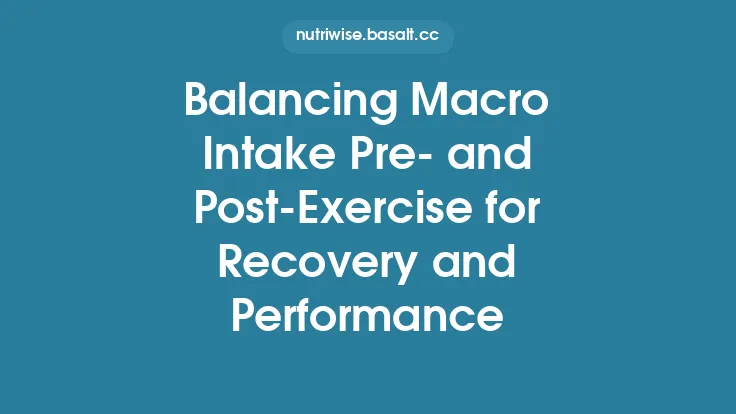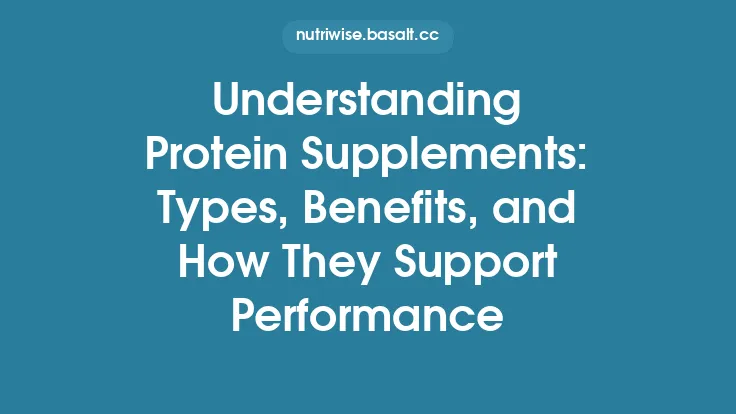Protein timing is more than a buzzword; it is a nuanced strategy that aligns nutrient delivery with the body’s physiological states to maximize performance gains and accelerate recovery. While the total amount of protein you consume each day remains the cornerstone of muscle maintenance and growth, *when* you ingest that protein can influence the magnitude of muscle protein synthesis (MPS), the rate of glycogen restoration, and the overall adaptation to training stress. This article delves into the mechanisms, evidence, and practical applications of timing protein intake for athletes, recreational lifters, and anyone seeking to get the most out of their training regimen.
The Science Behind Protein Timing
Muscle Protein Synthesis and the “Leucine Threshold”
When muscle fibers experience mechanical tension, metabolic stress, or muscle damage, they become primed for repair. The primary driver of this repair process is MPS, a cascade that is acutely stimulated by essential amino acids (EAAs), particularly leucine. Research indicates that a bolus of ~2–3 g of leucine is required to maximally activate the mTORC1 pathway, the molecular hub that initiates protein synthesis. This “leucine threshold” can be reached with roughly 20–30 g of high‑quality protein for most adults, though the exact amount varies with body size, training status, and age.
The Temporal Window of Sensitivity
After resistance exercise, the muscle’s sensitivity to amino acids is heightened for roughly 24–48 hours, with a pronounced peak in the first 4–6 hours. This period is often referred to as the “anabolic window,” though recent data suggest the window is broader than the classic 30‑minute post‑exercise myth. Nonetheless, delivering protein within the first few hours post‑workout can substantially augment MPS compared with delayed intake.
Interplay with Glycogen Replenishment
Endurance athletes must also consider glycogen restoration. Carbohydrate ingestion stimulates insulin release, which, in turn, enhances amino acid uptake into muscle cells. Pairing protein with carbohydrates (e.g., a 3:1 or 4:1 carb‑to‑protein ratio) within the early recovery phase can accelerate glycogen resynthesis while still supporting MPS.
Pre‑Workout Protein: Fueling the Session
Why Protein Before Exercise Matters
Consuming protein 1–3 hours before training can:
- Elevate circulating amino acid concentrations, ensuring a readily available pool for MPS during and after the session.
- Provide a modest insulin response that may help preserve muscle glycogen during prolonged or high‑intensity work.
- Reduce muscle protein breakdown (MPB) that occurs during exercise, thereby improving net protein balance.
Practical Recommendations
- Amount: 0.2–0.3 g/kg body weight of high‑quality protein (e.g., whey, soy, or a mixed plant blend) 60–90 minutes pre‑workout.
- Form: A shake or a light meal containing protein and a modest amount of carbohydrate (e.g., a banana with Greek yogurt) works well for most athletes.
- Timing: Aim for the protein to be digested and absorbed before the workout begins; overly heavy meals can cause gastrointestinal discomfort.
Intra‑Workout Protein Strategies
Is There a Need for Protein During Exercise?
For most resistance training sessions lasting under 90 minutes, intra‑workout protein is not essential. However, certain scenarios benefit from intra‑session amino acid delivery:
- Endurance events >2 hours (e.g., marathon training, ultra‑cycling) where muscle catabolism is pronounced.
- High‑volume resistance sessions (e.g., bodybuilding “pump” workouts) that deplete amino acid pools.
- Training in a fasted state where baseline amino acid levels are low.
What to Use
- Branched‑Chain Amino Acid (BCAA) or Essential Amino Acid (EAA) powders: 5–10 g per hour, dissolved in water, provide rapid absorption without adding significant calories.
- Hydrolyzed whey: Faster than intact whey, can be consumed in small doses (10–15 g) during longer sessions.
Post‑Workout Protein: The Anabolic Window Revisited
The First 4‑Hour Post‑Exercise Period
During the immediate post‑exercise phase, the muscle is most receptive to amino acids. Consuming protein within this window:
- Maximizes MPS rates.
- Helps shift the net protein balance from catabolic to anabolic.
- Supports glycogen resynthesis when paired with carbohydrates.
Dose and Composition
- Quantity: 0.25–0.4 g/kg body weight (≈20–40 g for most adults) of a fast‑digesting protein source.
- Leucine Content: Ensure at least 2–3 g of leucine; whey protein naturally meets this requirement, while plant proteins may need higher total grams or a blend to achieve the threshold.
- Carbohydrate Pairing: 0.5–1 g/kg body weight of carbs (e.g., fruit, rice, or a sports drink) can amplify insulin‑mediated amino acid uptake.
Extending the Window
If the immediate post‑workout meal is delayed beyond 4 hours, the body’s heightened sensitivity persists for up to 24 hours. In such cases, distributing protein evenly across subsequent meals (e.g., 3–4 meals containing 0.3 g/kg each) can still support robust MPS.
Protein Distribution Throughout the Day
The “Even‑Spread” Model
Research suggests that delivering 0.3–0.4 g/kg of protein per meal, spaced 3–5 hours apart, optimizes MPS across the day. This approach prevents periods of low amino acid availability that could otherwise limit muscle repair.
Practical Meal Planning
| Meal | Approx. Protein (g) | Example Foods |
|---|---|---|
| Breakfast | 20–30 | 3 eggs + 30 g oats + 1 cup milk |
| Mid‑Morning Snack | 15–20 | Greek yogurt + berries |
| Lunch | 25–35 | 150 g grilled chicken + quinoa + veggies |
| Pre‑Workout | 15–20 | Whey shake (20 g) + banana |
| Post‑Workout | 20–30 | Whey or soy blend (25 g) + rice |
| Dinner | 25–35 | 200 g salmon + sweet potato + salad |
| Evening Snack | 10–15 | Cottage cheese or casein (if tolerated) |
The exact numbers can be adjusted for body weight, training volume, and personal preferences.
Meal Timing and Circadian Influences
Aligning Protein Intake with the Body’s Biological Clock
Emerging evidence indicates that the circadian system modulates muscle metabolism. MPS appears to be more robust in the early afternoon compared with late evening, possibly due to fluctuations in hormone levels (e.g., cortisol, testosterone) and core body temperature.
- Morning: A protein‑rich breakfast can counteract the overnight catabolic state.
- Afternoon: This is an optimal window for a larger protein meal, especially if training occurs later in the day.
- Evening: While MPS is slightly reduced, a modest protein dose before sleep (e.g., 20–30 g casein or a slow‑digesting plant blend) can sustain amino acid delivery throughout the night, supporting overnight recovery.
Practical Takeaway
If training schedule permits, aim to place the largest protein‑containing meal within the 12:00–18:00 window. Adjust evening intake based on personal sleep patterns and tolerance.
Special Considerations for Different Training Modalities
| Modality | Primary Goal | Timing Emphasis |
|---|---|---|
| Strength/Power (e.g., weightlifting) | Maximize hypertrophy & strength | Pre‑ and post‑workout protein (20–30 g each) plus even distribution |
| Endurance (e.g., long‑distance running) | Preserve lean mass & replenish glycogen | Carbohydrate‑protein blend post‑session; intra‑workout EAAs for >2 h events |
| High‑Intensity Interval Training (HIIT) | Support rapid recovery | Immediate post‑workout protein (15–20 g) + carbohydrate |
| Team Sports (e.g., soccer, basketball) | Frequent bouts of activity | Small, frequent protein doses (10–15 g) every 3–4 h; intra‑session EAAs if >90 min |
| Older Adults (≥60 yr) | Counteract anabolic resistance | Slightly higher per‑meal protein (0.4 g/kg) and ensure leucine ≥3 g per dose |
Age, Gender, and Lifestyle Factors
Anabolic Resistance in Older Adults
With age, muscle becomes less responsive to amino acids—a phenomenon termed anabolic resistance. To overcome this, older individuals should:
- Consume ≥0.4 g/kg protein per meal.
- Prioritize leucine‑rich sources (e.g., whey, soy, or fortified plant blends).
- Ensure protein intake within 2 hours post‑exercise.
Gender Differences
While men and women exhibit similar MPS responses when normalized for body weight and protein dose, hormonal fluctuations across the menstrual cycle can modestly affect protein utilization. Some female athletes report heightened recovery needs during the luteal phase; modestly increasing protein intake (by ~10 %) during this window may be beneficial.
Vegetarian and Vegan Athletes
Plant proteins often have lower leucine density and digestibility. Strategies include:
- Using blended plant proteins (e.g., pea + rice) to achieve a complete EAA profile.
- Adding a leucine supplement (2–3 g) to a plant‑based shake if total protein is limited.
- Timing protein intake around workouts to ensure the leucine threshold is met.
Practical Tips for Implementing an Optimal Timing Plan
- Plan Ahead: Use a weekly meal‑prep schedule to allocate protein portions for each target window.
- Track Leucine: If you rely heavily on plant proteins, calculate leucine content (≈8 % of total protein for most sources) to ensure you meet the 2–3 g threshold.
- Utilize Convenient Sources: Whey or hydrolyzed protein powders are fast‑acting; casein or soy milk can serve as slower‑release options before sleep.
- Combine with Carbs Strategically: Pair protein with carbs when glycogen restoration is a priority (endurance sessions, heavy volume days).
- Hydration Matters: Adequate fluid intake supports amino acid transport and digestion; aim for 2–3 L of water daily, adjusting for sweat loss.
- Monitor Recovery Markers: Track performance metrics (e.g., squat depth, sprint times) and subjective measures (muscle soreness, fatigue) to gauge the effectiveness of your timing strategy.
Common Pitfalls and How to Avoid Them
| Pitfall | Why It Happens | Solution |
|---|---|---|
| Relying on a single “post‑workout shake” | Belief that one dose covers all needs | Distribute protein across 3–4 meals; include a pre‑workout dose if training fasted |
| Skipping protein on rest days | Assuming protein is only needed on training days | Maintain consistent daily protein intake to support ongoing repair and adaptation |
| Over‑emphasizing timing at the expense of total intake | Obsession with the “anabolic window” | Prioritize meeting total daily protein goals first; timing is a secondary optimization |
| Choosing low‑leucine sources for the post‑workout meal | Preference for taste or convenience | Supplement with leucine or select a blend that meets the leucine threshold |
| Consuming large protein meals late at night | Habitual late‑night snacking | Opt for a moderate, slow‑digesting protein (e.g., casein) if needed, and keep portions reasonable to avoid sleep disruption |
Future Directions in Protein Timing Research
- Chrononutrition: Ongoing studies are exploring how aligning protein intake with circadian rhythms can further enhance muscle anabolism.
- Personalized Nutrition Algorithms: Machine‑learning models that integrate genetics, training load, and sleep data may soon provide individualized timing recommendations.
- Novel Protein Forms: Hydrolyzed plant proteins and peptide‑based supplements are being investigated for faster absorption comparable to whey, potentially expanding timing options for vegans.
- Synergistic Nutrient Timing: Research into co‑ingesting omega‑3 fatty acids, polyphenols, or specific micronutrients with protein may reveal additive effects on recovery and inflammation control.
Bottom Line: While total daily protein remains the foundation of muscle health, strategically timing protein intake—pre‑, intra‑, and post‑exercise, as well as across the day—can fine‑tune the body’s anabolic response, improve glycogen replenishment, and accelerate recovery. By understanding the underlying physiology, respecting the leucine threshold, and tailoring intake to individual training modalities, age, and lifestyle, athletes and active individuals can extract maximal performance benefits from every gram of protein they consume.





